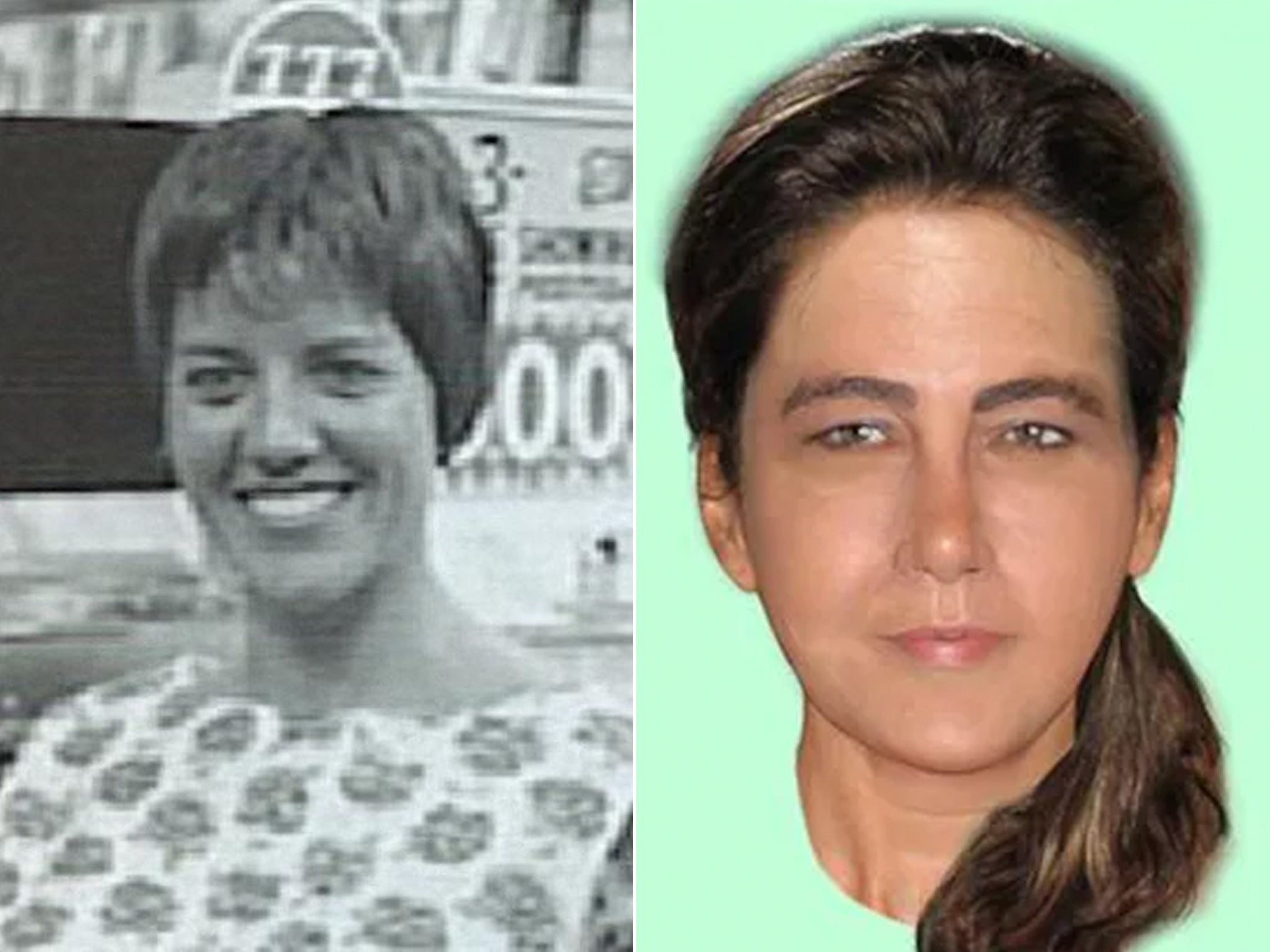Who killed The Lady of the Dunes? How Jaws could hold the answer
The Lady of the Dunes has captivated the world for almost 50 years as many attempts to identify the 1974 murder victim proved futile... Until now. The FBI announced this week that Ruth Marie Terry, 37-year-old Tennessee woman, had been identified as the Provincetown victim. But who was she? How did she get there? And, most importantly, who killed her and are they still alive? Sheila Flynn reports

Your support helps us to tell the story
From reproductive rights to climate change to Big Tech, The Independent is on the ground when the story is developing. Whether it's investigating the financials of Elon Musk's pro-Trump PAC or producing our latest documentary, 'The A Word', which shines a light on the American women fighting for reproductive rights, we know how important it is to parse out the facts from the messaging.
At such a critical moment in US history, we need reporters on the ground. Your donation allows us to keep sending journalists to speak to both sides of the story.
The Independent is trusted by Americans across the entire political spectrum. And unlike many other quality news outlets, we choose not to lock Americans out of our reporting and analysis with paywalls. We believe quality journalism should be available to everyone, paid for by those who can afford it.
Your support makes all the difference.There is a desolate beauty to the dunes near the very edge of Cape Cod, where the windswept shores are battered by the Atlantic and little more than scrub brush and trees can survive. It was here where an adolescent girl and a dog found a body, the head nearly severed and hands gone, on a July day in 1974.
The discovery by Provincetown, Massachusetts, set off a mystery that has captivated investigators to this day. Though a key piece of the puzzle has just been solved. On Monday, the FBI announced that they finally had a name for the heretofore unidentified victim, a woman who became known as The Lady of the Dunes: She was Ruth Marie Terry, a 37-year-old woman from Tennessee.
Until then, she had been the oldest unidentified homicide victim in Massachusetts.
Authorities held a press conference just hours after notifying Ms Terry’s relatives, and the revelations set off of a frenzy of new questions in a case that has flummoxed decades of detectives, drawn the fascination of countless armchair sleuths and could even have Hollywood connections.
Two days after announcing the Lady of the Dunes’ identity, investigators released another name - that of a man she married just months before her death. They appealed for more information about Guy Rockwell Muldavin, who died in 2002, but the details already available add even more sketchy elements to the story. He was married multiple times, suspected in the death of at least one of his wives and seemed to be a coast-to-coast, manipulative jack-of-all-trades.
The Lady of the Dunes mystery became a public obsession on 26 July 1974, when 12-year-old Leslie Metcalfe and her family were visiting the Cape Cod National Seashore. A dog with the group caught a scent and Leslie followed it; the dog started barking. That’s when Leslie spotted what she initially thought was a dead dear. She soon realized it was a human. She raised the alert and the crime scene would turn out to be particularly gruesome.

The decomposing body, which had been dead for up to several weeks, was that of a woman. Her reddish brown mane secured with a gold-flecked hair tie. Her head had nearly been severed. Both hands and one forearm were missing. The woman’s skull had been bashed in and she was naked but resting on a towel, her head placed on a pair of folded-up Wrangler jeans and a blue bandana.
Investigators determined that the woman was between about 20 and 40, 5’6 to 5’8, and weighed approximately 145 pounds. Her toenails were painted pink and she had expensive dental work that authorities valued at up to $10,000 and described as being in “the New-York style” of the time.
The fatal injury was her crushed skull, investigators found, and it was believed to be caused by a military-style entrenching tool. The removal of the victim’s hands was thought to be an attempt by the killer to hide the victim’s identity, their own or both.
There were no defensive wounds on the body, indicating that she’d either known her killer or been asleep at the time of the fatal attack.
Warren Tobias, retired acting police chief in Provincetown, has said the victim was “definitely posed” in her dunes location.
“She was lying out on a beach towel as if she was sunbathing,” he told People in 2018.
Detectives combed missing persons records and appealed for information, but there were no fruitful leads or IDs. In October of 1974, the Jane Doe -- who would eventually come to be called The Lady of the Dunes -- was buried in St Peter’s Cemetery in Provincetown, where her headstone still reads: “Unidentified Female Doe. Found Race Point Dunes. July 26, 1976.”

The complete inability to determine the Lady’s identity frustrated investigators for years as law enforcement regimes changed and new detectives threw themselves at the case while those who initially worked it kept digging even after retirement.
The body was exhumed in 1980 so blood samples could be taken. It was exhumed again in 2000 “to see if it matched that of a woman who came forward as possibly the mother of the victim,” the Cape Cod Times reported.
“A clay model has been made of the woman’s head, and age-regression drawings were completed in 2006,” the publication noted.
In 2010, the National Center for Missing and Exploited Children created an even more advanced composite 3D image. None of that yielded answers.
In 2018, retired chief Tobias theorised that the victim could have been from a foreign country or had no family, given that decades had passed without her identification.
As Monday would prove, the Lady of the Dunes turned out to be from the States.
“She was born in Tennessee in 1936,” FBI Special Agent in Charge Joseph Bonavolonta said Monday. “Ruth was a daughter, sister, aunt, wife, and mother. Investigators have also determined that in addition to Tennessee, she had ties to California, Massachusetts, and Michigan.”

He said the FBI had only received notification last week that her identity had been confirmed using forensic geneaology, which “combines the use of DNA analysis with traditional genealogy research, and historical records, to generate investigative leads for unsolved violent crimes.”
Two days after the announcement of Ms Terry’s identity, Massachusetts authorities released more names she may have been known by: Teri Marie Vizina, Terry M. Vizina, and Teri Shannon.
They also released the name of the man they said she married just months before her July 1974 killing: Guy Rockwell Muldavin, also known as Raoul Guy Rockwell and Guy Muldavin Rockwell.
Born in 1923, Muldavin was married at least five times and had been questioned in connection with the 1960 murders of his second wife and her daughter. He died in 2002 but authorities are appealing for information regarding his life and whereabouts in the years around Ms Terry’s murder.
It adds another possibility - and a very likely one - to an interminable list of theories stemming from professional investigators and armchair sleuths alike who’ve been poring over the case for decades.
One of the most high-profile threads of speculation actually stemmed from the son of King of Horror Stephen King himself. Author Joe Hill, one of Mr King’s three children, created a viral firestorm in 2015 when he spotted a woman in a scene from Jaws dressed almost exactly like the Lady of the Dunes.
The Steven Spielberg blockbuster, which hit theaters in 1975, was filming around a similar time about 100 miles away from Provincetown on Martha’s Vineyard. It was the talk of the Cape and the Islands that whole summer.
“It is impossible to say with complete precision when they filmed the ‘July 4th - Crowd Arrives’ sequence, which is where this shot appears,” Mr Hill wrote on his Tumblr. “But we know it was almost certainly shot in June, because they filmed all the ‘on island’ scenes they could early. The water was too cold for swimming, and the malfunctioning shark wasn’t ready for the ‘at sea’ material until late July.”
“We also know the Lady of the Dunes was alive in June and that the filming of JAWS was a big deal locally. Lots of folks turned up to try and get a peek at the stars, or the shark, or to see if they could sneak into a shot,” he continued
The hypothesis took off online and even spurred one showbusiness journalist to hunt down records for Jaws extras, to no avail; the film’s casting director has passed away.
This week, Mr Hill again raised the issue with denizens of the internet following news that the Lady of the Dunes had been identified. He tweeted out a screenshot of the woman in Jaws and the image of Ruth Marie Terry.
“What do you think, Twitter?” he asked, as users began scrutinizing everything from the pictured women’s jawlines to hair.
Mr Hill himself remains on the fence.
“My opinion: Maybe,” he tweeted on Tuesday. “Probably not? But maybe. The facial similarities are there -- so is the way she holds her shoulders. But the hair is really quite different, and I wonder if the woman in the #JAWS photo is too young.”
Then he seemed to reconsider, tweeting out other side-by-side images and writing: “Hair color is different. The rest? Well, see for yourself. They might not be the same person... but I also think one has to admit they might be.”
As amateur detectives around the world pore over pictures and details, authorities are working doggedly to solve the remaining mysteries surrounding Ms Terry’s murder.

Massachusetts State Police Colonel Chris Mason said on Monday during the press conference that the Lady of the Dunes case still haunts “generations” of officers involved and extended his condolences to the loved ones of Ms Terry’s who’d been similarly without answers for years.
“We know Ruth had family and friends who loved her,” he said. “And we are aware that this development has not been an easy one for them. So we keep them in our thoughts today during this difficult time. Certainly, during the years that they were in contact with her, they never envisioned the outcome for the child, the teenage girl, the young woman they knew, loved and cared about. We hope today's announcement helps shed some light on the many questions they have had these many years, and marks another step towards answering more of them.”
Mr Mason continued: “Today's identification of the Lady of the Dunes is not the end of the case or even the beginning of the end. But this achievement does mark an important milestone towards identifying Ruth’s killer.
“It represents a critical discovery that makes possible the rest of the work that lies ahead,” he said. “Now, almost half a century since her own voice was silenced in the most horrible of ways, we focus our work entirely on determining what Ruth Marie Terry did in life; on what led her to the easternmost point of our state, to the dunes of Provincetown.”
Join our commenting forum
Join thought-provoking conversations, follow other Independent readers and see their replies
Comments